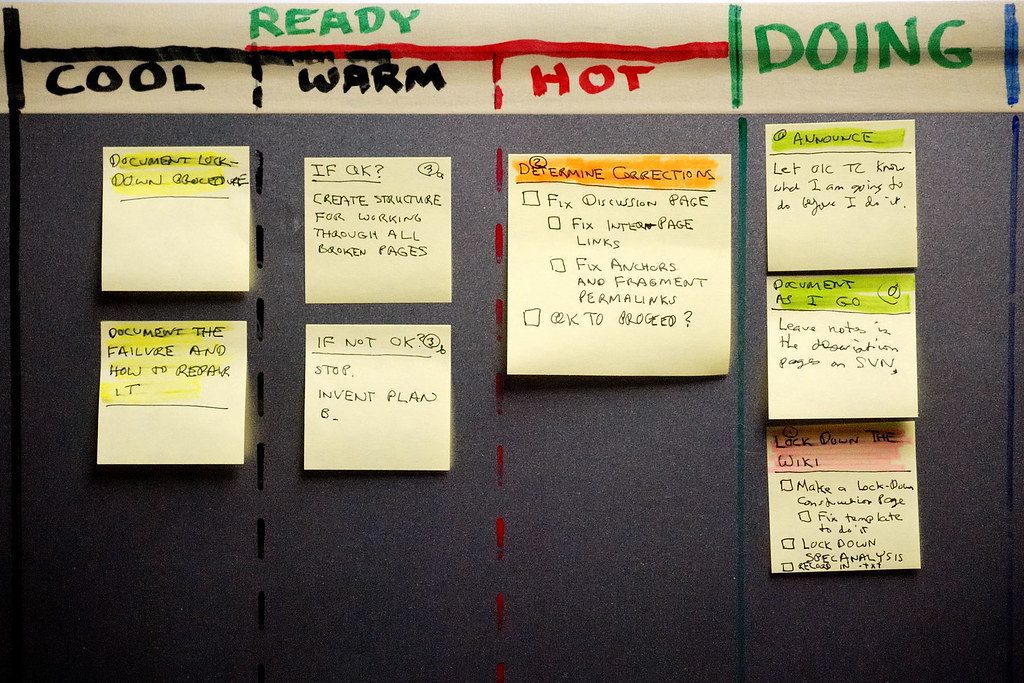Kanban, a Japanese term which translates to “billboard” or “visual sign,” is a popular project management methodology that emphasizes visualizing work, limiting work in progress, and maximizing efficiency. Initially employed in Toyota’s production system to improve manufacturing efficiency, Kanban has since been adopted by various industries, especially in the fields of software development and IT operations.
Origins of Kanban
The Kanban system finds its roots in the 1940s when Toyota observed that shop floors often operated more efficiently when they mirrored supermarket stocking methods: just enough products on the shelves to meet consumer demand, restocking only what was sold. This observation led to the development of the Kanban system, an approach aimed at creating a “pull” production system rather than the traditional “push” system.
Core Principles of Kanban
1. Visualize Work
By visualizing tasks on a Kanban board, teams can quickly understand the status, progress, and issues surrounding a project. Tasks are represented as cards and are moved through columns (usually labeled as “To Do,” “In Progress,” “Review,” and “Done”) as they progress through the workflow.
2. Limit Work in Progress (WIP)
By limiting WIP, teams can focus on completing tasks rather than continually starting new ones. This reduction in multitasking enhances the quality of work and accelerates delivery.
3. Manage Flow
This principle focuses on monitoring and optimizing the workflow to ensure a steady and sustainable pace, identifying and removing any bottlenecks.
4. Make Process Policies Explicit
Everyone should understand the operational guidelines, ensuring consistency in the workflow and clarity when issues arise.
5. Implement Feedback Loops
Regular reviews and adaptations to the process allow the team to improve and adapt continually.
6. Collaborative Improvement
Kanban recognizes that the best insights and improvements come from the collective knowledge and skills of the team. Hence, it emphasizes team collaboration in problem-solving.
Kanban Board
Central to the Kanban methodology is the Kanban board. It can be physical, using post-it notes on a whiteboard, or digital, using tools like Trello or Jira. The board is divided into columns representing stages of a process, and as tasks progress, they are moved from one column to the next.
Benefits of Kanban
1. Flexibility
Kanban is an inherently adaptable methodology. New tasks can be added to the board at any time, making it suitable for environments where change is frequent and expected.
2. Improved Efficiency
By visualizing tasks and limiting WIP, teams can quickly identify bottlenecks and areas of inefficiency. This awareness allows teams to address problems in real-time, reducing project delays.
3. Enhanced Collaboration
With every team member able to see and understand the project’s status, collaboration is enhanced. It encourages open communication and shared responsibility.
4. Continuous Delivery
For software development, Kanban promotes continuous delivery of software, ensuring that users receive updates faster.
5. Reduced Waste
By focusing on delivering only what is necessary and eliminating tasks that don’t offer value, resources are used more efficiently, reducing waste.
Limitations and Challenges of Kanban
1. Not Ideal for Large Projects
Kanban works best for ongoing processes or smaller projects. Larger, more complex projects might benefit from methodologies that incorporate more planning, like Scrum or the Waterfall method.
2. Can Lead to Oversimplification
The visual nature of Kanban can sometimes lead to oversimplification of complex tasks. This can make it harder to estimate the time or resources required for individual tasks.
3. Requires Discipline
For Kanban to be effective, teams must be disciplined in their adherence to the methodology’s principles. This includes regularly reviewing and updating the board and respecting WIP limits.
Conclusion
Kanban is a powerful, visual-based project management methodology that emphasizes efficiency, collaboration, and continuous improvement. While it offers many benefits, it’s essential to understand its limitations and ensure it’s the right fit for a given project or team. As with any methodology, the key to success with Kanban lies in understanding its principles thoroughly and adapting them as necessary to fit the unique needs and challenges of each project.
